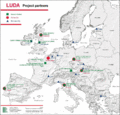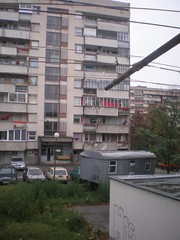LUDA Approach
 samedi, juin 24, 2006 at 01:38
samedi, juin 24, 2006 at 01:38 LUDA stands for: "Large Urban Distressed Areas". It is a methodology, developed under the 5th Research Framework of the EU by four academic research institutes and twelve city partners, as described in this scheme:

Click for full image The main LUDA product, its e-Compendium, was first publicly announced in Brussels on June 22, 2006.
For an introductory description of LUDA and the Compendium, see the e-urban Journal Post "LUDA e-Compendium: A Diamond found in the Rubble" (22.6.06)
On pp 54-56 of its 2nd on-line Handbook, the LUDA team defines the specific benefits of their methodology as compared to former approaches:
 ----------------------------------------------------------
----------------------------------------------------------
For a PDF-version of this text, click here: LUDA HB2.7 pp 54-56
Conclusion:
Contribution of the LUDA approach to improving quality of life in distressed urban areas
The LUDA approach outlined above in many ways contributes to improving quality of life in areas of urban deprivation . Backing on lessons learnt from the experiences with different regeneration programmes as well as with individual cases of LUDA regeneration [see handbook E6] the main benefits of the LUDA approach can be described as follows:
1. LUDA is an integrative quality of life approach.
It puts emphasis on the five dimensions of the
‘Diamond of Quality of Life’:
In this it is clearly discernable from other integrative approaches oriented towards urban regeneration, such as URBAN.
2. The LUDA approach puts high emphasis on the participation and inclusion of stakeholders from inside the area as well as from outside
It includes stakeholders into the planning and improvement activities right from the beginning. Therefore their active participation, their ideas and perceptions play an important role in the LUDA approach.
3. The LUDA approach distinguishes different perceptions on quality of life.
- A first perspective is related to the objective situation as it may be represented by statistical data.
- A second perspective takes into consideration the perception of insiders, i.e. those who live and work in the LUDA area, such as inhabitants, owners of businesses, employees.
- The third perspective respects the perception of outsiders, such as political decision makers, planners, investors etc. who may have an image of the area but who do not necessarily know the area.
This differentiation helps to discern the different stakeholders’ views.
4. The LUDA approach adds a functional view definition of distressed areas.
Distressed areas are not seen as homogeneously problematic but they are recognised as having both pockets of problems and pockets of potential . These need to be uncovered from the beginning as they form the basis of the improvement activities. The art of LUDA im provement is then to find solutions for the problems and make best use of the area’s potential.
5. The LUDA approach is a strategic approach.
Strategic planning plays an important role. The typical LUDA improvement process includes the identification of distressed areas through quantitative techniques; the selection of the regeneration programme and the evaluation of it. Although there may not be a specific procedural order, the individual elements of the approach are all relevant in improvement process.
6. The LUDA approach strongly promotes a call for institution building.
Institution building is necessary because it is crucial for making municipalities prepared for the complex work of LUDA improvement. Within the traditional sectoral channels of municipalities there is little room for comprehensive approaches. Therefore it is recommended to form inter-sectoral and inter-disciplinary working teams for LUDA improvement within or outside of municipal administrations. They should have enough freedom to move and enough authority and capacity to establish stable links between the different stakeholders.
7. The LUDA approach strongly promotes a comprehensive quality of life monitoring.
In this it can be discerned from other monitoring activities in urban regeneration which concentrate on sectoral activities or on the progress of programme activities only without taking into consideration potential negative (or positive) side-effects, such as gentrification or displacement of inhabitants due to sharply increasing land values and rents. The LUDA monitoring takes into consideration all five dimensions of quality of life and it identifies potential negative or positive side effects during the improvement process within the LUDA.
8. The LUDA approach is an approach which is not primarily oriented towards funding.
Although money is the fuel which makes the engine of LUDA improvement run, it is not the only ingredient in driving the improvement into the best possible direction and to spend money wisely. Many urban regeneration activities are heavily oriented towards certain funding channels which may lead to the situation that the identification of problems is not based on the actual or perceived situation of an area but is oriented towards the availability of funds (funding priorities determine actions instead of a situation where problems call for solutions ). LUDA demonstrates that the improvement task exists independently from funding programmes and that improvement activities can be initiated irrespective of their existence.
9. This all shows that the LUDA approach is an approach calling for good governance.
Good governance is necessary in order to involve the different stakeholders (public, private) in a way which brings them in early and which keeps them interested in the improvement activities over a long time. Moreover, it contributes to the qualification of municipal staff by widening their traditional sectoral and administrative perceptions into a more comprehensive understanding of LUDAs, and by creating a network of multipliers within and outside of cities which decide to start LUDA improvement processes in the described way.
-------------------------------------------------------------------------------------------------------------












